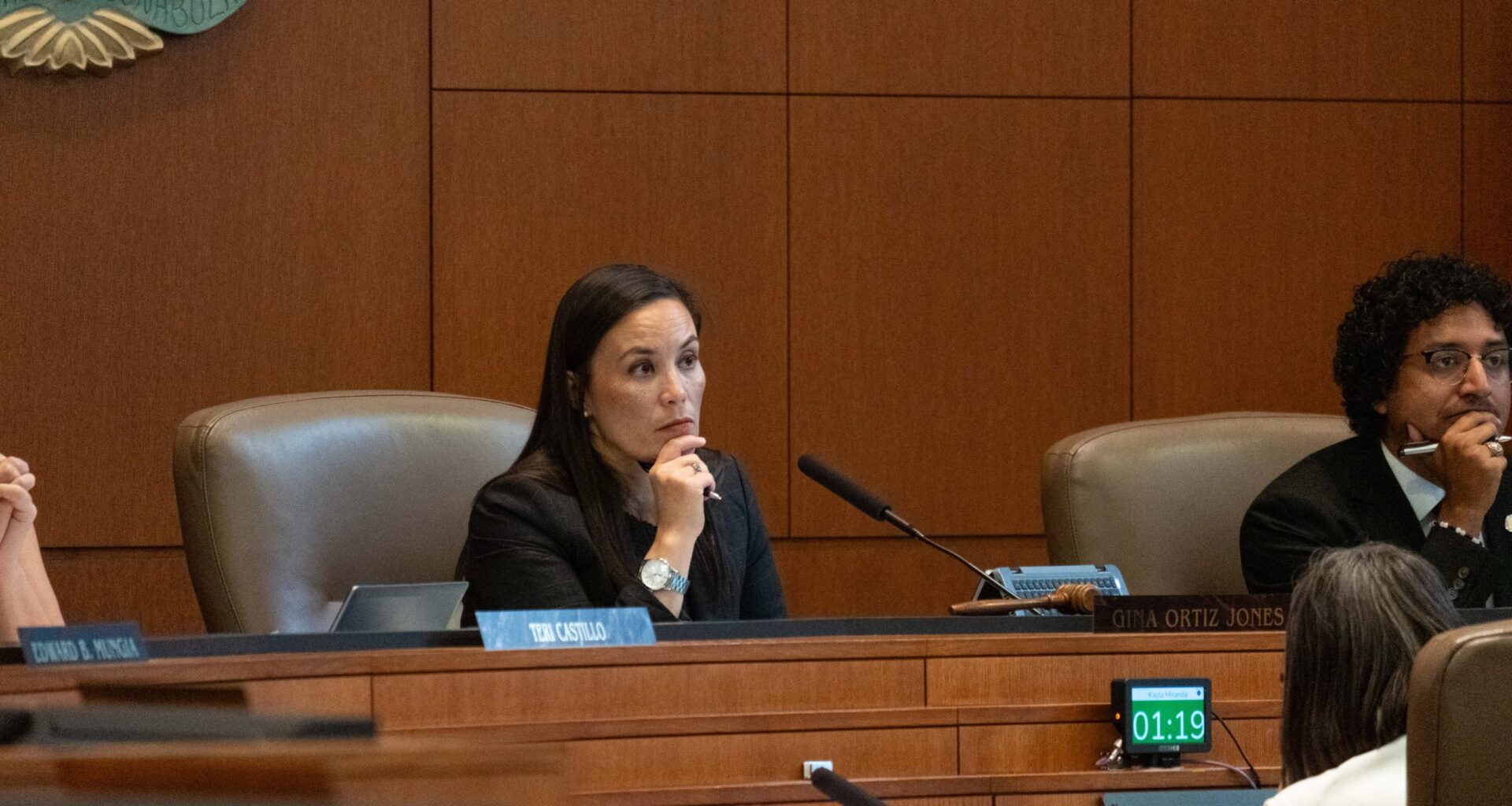San Antonio’s new mayor once climbed to the highest tier of military leadership through an Army program that trains “adaptive leaders” to solve “complex operational problems.”
So far, it’s proving little match for city government.
Gina Ortiz Jones’s unusual political path involved leaving after John Jay High School to pursue a career in national security, and then returning home to best a field of 27 candidates with that experience as President Donald Trump was returning to office.
Now in the midst of a federal government shutdown — with a White House planning major cuts to the social safety net at the same time the city is negotiating a major downtown development deal — Jones is on a mission to get city leaders thinking bigger about the challenges they’ll soon face.
“Balancing the near-term [needs] with a really strong appreciation for the fiscal s—show that we’re about to experience, trying to be strategic and compassionate, while also doing our due diligence, that is where I am,” Jones said in a recent interview at her office.
Yet Jones’ first months have hardly been focused on the big threats she’s most worried about.
She took over leading a council of members with longer local government resumes who prefer a more coalition-building approach.
They spent much of her predecessor’s final term stripping power from an already weak mayor’s office, leaving Jones to navigate the role with little traditional political leverage beyond assigning some boards and committees.
Four months in, disagreements over the mayor’s authority have resulted in weeks-long fights over peafowl protections and whether to continue policy proposals submitted by members no longer on the council.
Asked whether she miscalculated the mayor’s power when she first arrived, Jones declined to say.
“What I knew is that I was going to work hard to serve my community, because I think that’s what my community deserves, and I think there is a lot that can be done when you’re leading the seventh-largest city in the country,” said Jones, who pointed to her recent economic development visit with Taiwanese manufacturers and fighting to protect local military installations with leaders at the Pentagon as examples of her most impactful work since taking office.
“I’ll work within the contours that I have,” she said.
 San Antonio Mayor Gina Ortiz Jones, center, thanks Taiwan Electrical and Electronic Manufacturers’ Association chairman Winner Yu, left, Allen Cheng of Taiwan Eastbound Alliance and other Taiwanese delegates for visiting San Antonio before their meal at Best Quality Daughter on Thursday, Aug. 28. Credit: Amber Esparza / San Antonio Report
San Antonio Mayor Gina Ortiz Jones, center, thanks Taiwan Electrical and Electronic Manufacturers’ Association chairman Winner Yu, left, Allen Cheng of Taiwan Eastbound Alliance and other Taiwanese delegates for visiting San Antonio before their meal at Best Quality Daughter on Thursday, Aug. 28. Credit: Amber Esparza / San Antonio Report
But on a dais full of fellow progressives, the newly empowered council has left Jones standing alone on multiple 10-1 procedural votes. She also missed her first shot to slow negotiations on the downtown Spurs arena — raising early questions about whether foes can just go around her for the next four years.
“The people of San Antonio need a council that works together,” said recent interim District 2 Councilman Leo Castillo-Anguiano, one of Jones’ few reliable allies and an outspoken critic of the arena deal.
“I do think that I see a consensus within council. … [But] if people know that you as a council cannot work together … they’re going to start picking and choosing who they want in and who they want out.”
Those close to the mayor say she’s working rapidly behind the scenes to bring others on board in a city largely in agreement about its major challenges but reticent to put its trust in a newcomer to solve them.
The balance of power
The pushback comes as little surprise, said former Westside Councilman Juan Solis, who has observed many structural changes in San Antonio’s decades-long effort to rebalance traditional power structures with a financially vulnerable community.
From single-member districts in the 1970s, to professional salaries in 2015 allowing a wider variety of people to serve, Solis said many shifts now celebrated as progress came with growing pains at the time.
This year voters overwhelmingly bought into Jones’ populist approach during the mayoral election.
Yet her early months have been dogged with criticism from insiders who wanted someone in the mold of the charming (often male) mayors of recent past, and now point to Jones’ struggles building consensus as evidence she can’t lead.
Regardless of their popularity, the last council felt too-powerful mayors could bypass the will of the people, so they dusted off a little-used policy to put items on the agenda with as few as two colleagues’ support.
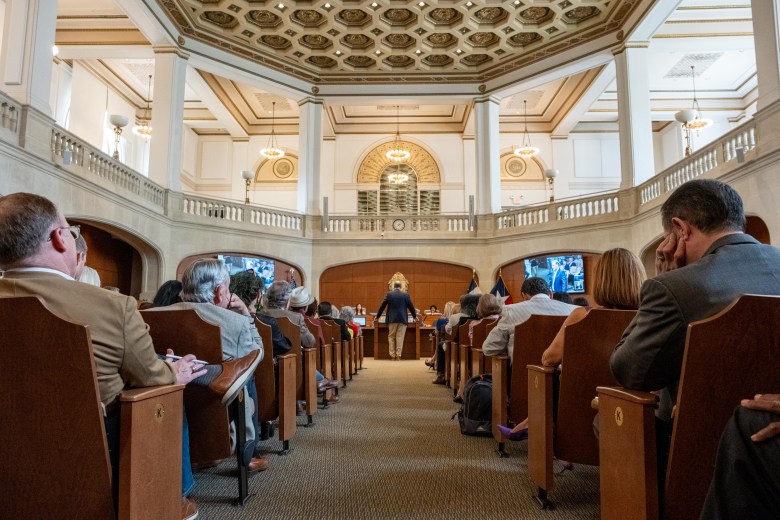 City Council chambers during a special session to discuss financing options and a timeline for Project Marvel on Friday, July 25. Credit: Amber Esparza for the San Antonio Report
City Council chambers during a special session to discuss financing options and a timeline for Project Marvel on Friday, July 25. Credit: Amber Esparza for the San Antonio Report
They also amended the city code to make sure their ideas move through the committee process whether the mayor wants them to or not.
“Before [Jones took over], the manager and the mayor were kind of big,” Solis said. “The mayor wanted to get something done, the manager said ‘Sure, let me make sure I get this done and work with the council members accordingly.’
Now, you’re seeing the possibility that [city staff has] to work with council members because of that new three-person rule. … So who gets priority?”
So far, the answer hasn’t been Jones.
Over the council’s July recess, an unexpected email from the new mayor’s office informed members of new policy-making procedures that Jones believed would improve their workflow — identifying costs before a project starts, determining whether a solution could be reached without a new policy, and resubmitting pending policies to be reviewed by the new council.
But council members pushed back, using three-signature memos to air their grievances and continue agendizing proposals anyway, including a new policy ensuring any further workflow changes must first go to them for approval.
Asked about the early power struggle with council, Jones brushed it off as a distraction from the issues San Antonians care most about.
“I’m focused on the people, not the petty,” she said. “There’s real s— we should be focused on.”
But it’s all happening against the backdrop of a government where most day-to-day operations are overseen by the city manager — opening up a political path for major, city-shaping ideas to move with any six council members’ support.
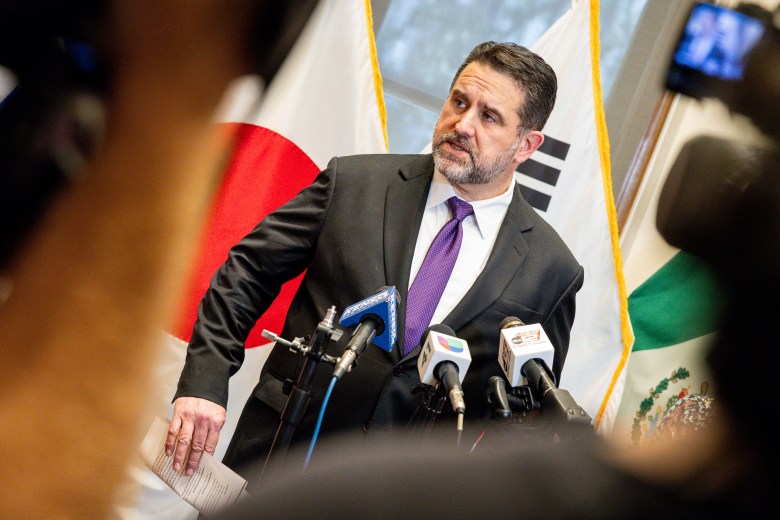 San Antonio City Manager Erik Walsh comments on the government shutdown at a press conference on Oct. 1. Credit: Amber Esparza / San Antonio Report
San Antonio City Manager Erik Walsh comments on the government shutdown at a press conference on Oct. 1. Credit: Amber Esparza / San Antonio Report
Take the Spurs arena plan, which started long before Jones’ time at City Hall, but against her wishes received most of the permissions needed to move forward during her administration.
City Manager Erik Walsh is now one of the most highly paid city executives in the state of Texas with no limits on his contract, thanks to an expensive campaign the business community helped bankroll last year, plus unilateral authority to sign off on contracts up to $2.5 million.
He hashed out a term sheet with the team’s owners and said enough members called him asking to put it for a vote, which passed 7-4.
“You either trust this team … or you don’t,” said Councilwoman Phyllis Viagran (D3), one of the members most adamant about not delaying the deal.
Focus on the numbers
Jones now lives in a world where much hinges on her ability to court allies and build alliances — a clear challenge for a leader who more often relies on wit than charm.
She entered the mayor’s race with more national political allies than local ones, but quickly caught attention from longtime organizers with her biting criticism of a potentially $4 billion sports and entertainment district known as Project Marvel.
“I didn’t know her from the past [congressional races]… but I heard her in an environmental justice debate and I was impressed,” said Esperanza Peace and Justice Center leader Graciela Sanchez, who added that Jones was trying to track down UTSA Professor Heywood Sanders’ book questioning the promised economic benefits of major development projects. “I was like, ‘Oh, who is this person that’s interested in learning what Heywood has to say about convention centers?’”
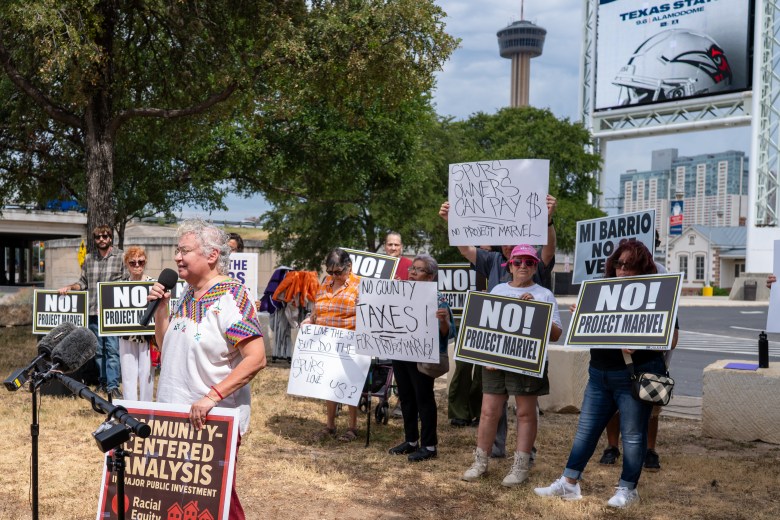 Graciela Sanchez speaks while members of No! Project Marvel stand behind her with signs outside the Alamodome during a protest on Aug. 4. Credit: Diego Medel / San Antonio Report
Graciela Sanchez speaks while members of No! Project Marvel stand behind her with signs outside the Alamodome during a protest on Aug. 4. Credit: Diego Medel / San Antonio Report
Jones’ questioning of the math helped her stand out from the pack and turned out to be good politics, according to Jones’ campaign pollster.
“[My approach is] different from how it’s been done, but I think that’s why I was voted in, because I have that range of experiences, and a set of values that I think very much marry up with this community,” Jones said in a recent interview. “[That includes] asking the tough questions and not being scared about the answers.”
Now that she’s secured the role, however, Jones’ tendency toward data and research has started to cut both ways.
In nearly every interview she does her homework to make her case, for example, an economic development study from the national consulting firm McKinsey & Company, and a state list of flood control projects she’s built her priorities around for the next infrastructure bond.
But for those who’ve been working on such issues for years, it can feel dismissive and out-of-touch.
Most notably her continued insistence that the city needs an independent economic impact study on Project Marvel has roiled some who worry her roadblocks will push the team will leave San Antonio — and cast Jones as an outsider unconcerned with whether they stay.
 Peter J. Holt, chairman of Spurs Sports and Entertainment, speaks at the “Win Together” campaign kickoff rally on Sept. 6. Credit: Blaine Young for the San Antonio Report
Peter J. Holt, chairman of Spurs Sports and Entertainment, speaks at the “Win Together” campaign kickoff rally on Sept. 6. Credit: Blaine Young for the San Antonio Report
Jones said she’s learning and evolving. She’s meeting with residents and stakeholders around the city, including those who want to see a more collaborative approach.
“Feedback is good, whether I get it from a town hall or business leaders,” she told the Report. “I also think it’s been helpful for them to hear from me, and what I’m working to accomplish, because I think sometimes that may not come across.”
Gathered with some of the city’s biggest political donors and lobbyists at the private Club Giraud last month, she delivered her thoughts through a new lens.
Jones described what keeps her up at night as mayor: Flattening city revenue and stagnant wages for residents at a time when federal cuts are about to decimate Metro Health’s budget, like many other social safety-net type programs.
Against the federal backdrop, Jones says she’s not against the city helping downtown development through a new sports and entertainment district, but she wants San Antonio to be a more shrewd negotiator.
“Lots of analysis shows the most lucrative aspects of those deals are on the naming rights, the parking and the concessions,” Jones said. “There is no appetite to raise the property tax. So how else do we meet the [city’s growing] needs?”
Much of that is already spelled out in the term sheet the council agreed to last month, which hinges on Bexar County voters’ approval of Prop. B on Nov. 4.
But Jones is asking the city not to issue bonds for its portion of the arena funding without a public vote sometime in 2027 — something city staff says isn’t legally required, and which she’d still need colleagues who green-lit the other deal to agree to.
“It’s more time to negotiate, right?” Jones said of the idea. “We will have a clearer understanding of just how dire our financial circumstances are … [and] more information from the independent economic study. … All of those things are needed given the size of this investment.”
Naturally, said Louis Escareño, an attorney and LGBTQ+ chamber leader who is among the rare business leaders in the mayor’s inner circle, it’s tough to be the bearer of bad news.
Of the five Texas cities using Project Finance Zones to pay for venue projects, Houston Chronicle columnist Chris Tomlinson wrote, Jones is the only mayor asking for her own numbers.
“She’s raising some really legitimate questions, and are they hard questions? Absolutely,” said Escareño, who pointed to the city’s visceral reaction to a December 2024 Texas Monthly story asking why San Antonio is a boomtown that’s still plagued by poverty. “It’s painful to hear we’re poor.”
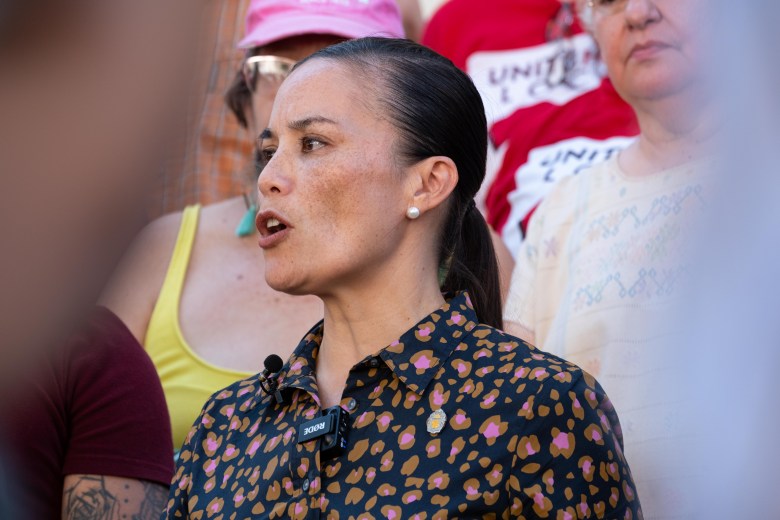 San Antonio Mayor Gina Ortiz Jones calls for an “independent economic analysis” of the Spurs downtown arena project at a press conference about Project Marvel on Aug. 18. Credit: Amber Esparza / San Antonio Report
San Antonio Mayor Gina Ortiz Jones calls for an “independent economic analysis” of the Spurs downtown arena project at a press conference about Project Marvel on Aug. 18. Credit: Amber Esparza / San Antonio Report
But Escareño stressed the impact Jones has when speaking from the heart about the broader fiscal landscape in front of audiences that understand executive-level responsibilities.
“I wish there had been cameras in the room. I wish that was recorded,” he said of the Club Giraud fundraiser. “[They] got to see the person that I know, and that people have voted for, who is deeply committed to making a difference and to doing things differently than they’ve been done in the past.”
‘Moving the ball forward’
On her desk in the mayor’s office, Jones keeps a mug from her time at the U.S. Army’s School of Advanced Military Studies (SAMS), an elite program with alumni who refer to themselves as the Jedi Knights.
The program is known for producing generals, Jones said, but she was admitted as a civilian while working for the Defense Intelligence Agency before she went on to become Air Force undersecretary. She believes it’s also good training for some of the many challenges now facing San Antonio.
“My entire career has been in national security, where you better have done your due diligence, otherwise you lose all your credibility, or more importantly, lives are lost,” Jones said. “That’s the seriousness with which I approach this job, and I think that’s what the people deserve.”
This week she’ll have the council doing so-called tabletop exercises intended to help groups manage simulated emergency situations. In this case, it’s to plan their next moves if federal grants covering roughly $153 million in their fiscal year 2026 budget evaporate.
Those cuts have loomed over the city for months, but Congress hasn’t been able to pass a spending bill since the new administration took office, and stopgap spending measures have so far continued popular programs that the new administration plans to gut.
“We have to understand what we can and can’t do as a result of some of that loss in that funding, and if we still think things are important, how are we going to do them?” Jones told the Report. “It’s that level of thinking, structured problem-solving, breaking the problem down to what is manageable, and then moving the ball forward.”
While Jones’ integration of military-style procedures at City Hall have so far not been popular with fellow council members — she made them give up their cell phones during executive session and her staff communicated through encrypted emails — she’s optimistic this one will finally bring them together.
“We would call it at the Pentagon, ‘war game,’” Jones said at a recent breakfast with business leaders. “We might not have all the answers, but how can we prepare ourselves?”

